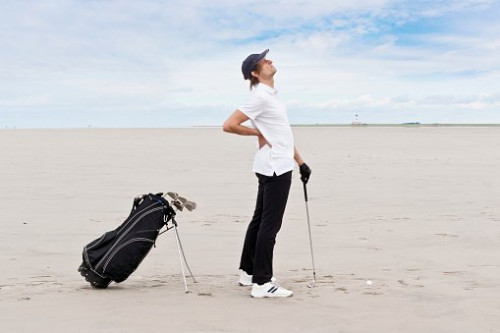Should I play golf with a sore back?
Are you one of 24 million Americans that plays golf? Then this article is for you.
The repetitive action of swinging a golf club can be either the best thing or the worst thing if you a suffering from back pain.
After treating hundreds of passionate golfers for back pain, one of the most common forms of feedback we receive is that sometimes golf makes you feel better, whilst other times it leaves you in terrible pain for days.
In this article we will clarify why this is the case, and hopefully give you some guidance to know when is good to push through the pain and stiffness and when it is best waiting for your symptoms to settle down before hitting the fairways.
The most common cause of back pain is an excessive lordotic lumbar curve (or an overly arched lower back/ swayback to keep it simple).
The excessive curve compromises the joints and shortens the muscles of the lower back as both the joints and the muscles are jammed closer together.
Muscular imbalances create the excessive curve and the severity of the curve or jamming of the lower back frequently changes. Hence why sometimes you are in pain, and other times you are fine.
Why all of this information is important to the golfer is due to the importance of lumbar (or lower back) freedom of movement required in the hip and back rotation of a golf swing.
If the back is severely jammed to the point where the facet joints are touching - the repetitive action of a golf swing is not going to end well. Whereas, if the back is not too jammed and the facet joints can still function, even if the muscles of the back are stiff and sore, the action of the golf swing can progressively stretch out the painful muscles leaving you feeling better than before your 18 holes.
So, if you suffer from back pain, however you find golf to alleviate your symptoms, your condition is most likely muscular, so getting out there as regular as possible is the best thing for you.
If you fall into the category where sometimes you feel better, sometimes you feel worse, it's time to start tuning into the signs and choose your battles wisely.
The following are some great tips or guidance for when it may be best to leave your round until your back settles:
- Back arches or extensions feel more painful than usual (a sign that your facet joints are compromised)
- Lower back rotation, after a hot bath or shower feels no better than before. (a sign that your pain is not purely muscular)
- Hips are extremely tight. (the deep muscles of the hips, when tight cause the pelvis to tilt forward, which increases the excessiveness of the lordotic curve.)
So, if you suffer from lower back pain and love golf, we strongly recommend you become more familiar with the constant changes that occur to your hips and lower back. Forming habit of stretching and carrying out range of motion exercises will provide you with accurate insight to the days where playing golf will help you, however more importantly identifying the day's best suited to meeting your friends at the 19th hole.
Back Solution across America has a proven record with acute and chronic back pain sufferers exceeding in excellence across the country. We have treated thousands of patients that range from Olympic athletes, professional athletes as well as everyday pain sufferers. Our rapid growth across the country will ensure a local clinic will be in your area soon to address you acute and chronic back pain.

